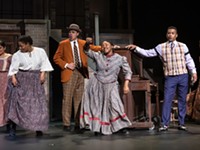Fringe Fest 2013 Reviews: "A Man, A Magic, A Music," "Bag of Tricks," "Ping," "Same Sex Shakespeare"
By Eric Rezsnyak[
{
"name": "500x250 Ad",
"insertPoint": "5",
"component": "15667920",
"parentWrapperClass": "",
"requiredCountToDisplay": "1"
}
]
“A Man, A Magic, a Music” is a one-man show starring Movin’ Melvin Brown, playing at Geva Theatre Nextstage as part of Fringe Fest. The piece is essentially Brown’s life story as told through a retrospective of black pop culture from the 1950’s through the early 21stcentury. Brown was bitten by the showbiz bug at an early age and he never got over it. He’s spent his life ever since singing, dancing, and telling stories.
Brown is known as “Movin’ Melvin” for a reason -- he’s a fantastic dancer. In this show he taps, clogs, and even does a striptease (that was…a surprise). His movements are full of joy; effortless. Frankly, it’s a shame that he doesn’t dance more in the show. Instead, most of the 90-minute program is devoted to Brown singing either snippets or full-length versions of classic songs by The Platters, Sam Cooke, and other legendary black artists. Those icons clearly had a profound effect on Brown and his career, and he skillfully mimics them here, slipping in the mannerisms and inflections of Ray Charles, James Brown, Louis Armstrong.
But while dancing seems to come naturally to Brown (astonishingly, he says he took up tapping fairly late in life), you can hear how hard he’s working whenever he sings. His voice is fine, and has the soul required to sell the gospel, blues, r’n’b, and other genres featured here. But he struggled significantly with his upper register at the performance I attended.
There was also an uncomfortable moment where the show came to a screeching halt when a music cue was missed leading into “When the Saints Come Marching In.” Brown eventually got things back on track but it was awkward for a solid minute or so. He’s a pro, though, and knows how to woo an audience through his genial nature, a laid-back vibe, and some very funny jokes that he nicely underplays. I felt the show went on too long, but the rest of the crowd seemed to eat it up.
(“A Man, A Magic, A Music” also takes place Sunday 9/22 3 p.m., Tuesday 9/24 6 p.m., Wednesday 9/25 9 p.m., Thursday 9/26 7:30 p.m., and Friday 9/27 8:30 p.m. at Geva Theatre Nextstage. Tickets cost $16.)
I did not respond at all positively to “Bag of Tricks,” put on at MuCCC by Juxtapose. The description of the event promised hip-hop aesthetics mixed with contemporary ballet, and group members started the show by teasing a variety of props and several surprises. The big surprise for me was that there was so little dancing. I recognize that there are basically no rules in modern dance. It is what you want it to be. But up until the fourth and final number, in which most of the group’s dancers were up and continuously moving (one still spent the bulk of that number rolling around on the floor in a bunch of crumpled papers), the pieces were largely defined by dancers either standing still with expectant looks on their faces, or walking/running around the stage in unison.
Quiet moments and stillness can be effective punctuation tools in dance. But when that’s the majority of what you’re giving an audience, with only brief bursts of actual movement, the content comes off as so subtle that it verges on nonexistent.
As for the props, each of the four numbers did indeed concern one or more everyday items. In the first, the dancers moved through a small sea of balloons on the floor (except for the one helium-filled smiley face that the dancers all coveted). In the third, a dancer picked up, threw down, or let a table fan blow around playing cards. In the fourth the aforementioned crumpled papers -- apparently dozens of those fortune-telling squares kids used to make in grade school -- were…just kind of there. Which brings me to my point: props can be extremely effective when deployed properly, and I think this troupe had some interesting intentions when selecting the objects. But the items were used so inconsistently throughout the numbers that it seemed, to me at least, that they were cool ideas that were never fully fleshed out through a dance vocabulary.
By the second number, inspired by Audrey Hepburn, I realized that what Juxtapose has going for it is impeccable style. From the deconstructed clothing items in the first piece to the visually interesting dresses in the final number, these numbers actually seemed more like moving fashion spreads than dance performances. Which is not a bad thing. It’s just, for me, “Bag of Tricks” was a clear case of style over substance.
Local playwright Nancy Preston Stark’s “Ping” has been performed at least once or twice before, and I keep trying -- and failing -- to see it. The grown-up sex comedy has always garnered good reviews. I finally caught Greater Rochester Repertory Companies’ production of it Saturday night at RAPA’s East End Theatre, directed by Allan O’Grady Cuseo. Indeed, it is a charming 60-minute play that will appeal in particular to older audiences, but still elicited laughs from viewers of all ages.
Denise Bartolo plays Phyllis, wife of recently retired hypochondriac Dick (Peter Elliott). When the play begins Dick is a mess of neuroses, and Phyllis urges him to talk to his doctor about what she assumes is a case of depression that some medication might mitigate. Dick’s doctor does indeed prescribe some pills, but not the kind Phyllis was expecting. This medication improves Dick’s mood by putting lead back in his pencil, and soon Phyllis finds herself exhausted by all the unwanted sex she’s getting. Enter undersexed, overly flirty next-door neighbor Lil (Diane Chevron), who might just provide a solution to the problem -- or inadvertently make it worse.
Stark’s script is topical and has a nice, rapid-fire cadence. The cast shares an easy, realistic chemistry, especially Bartolo and Chevron as gossipy buddy neighbors. A nice, frothy respite from some of the darker material I’ve seen at Fringe.
(“Ping” will also be performed Thursday, September 26, 6 p.m. at RAPA’s East End Theatre. Tickets cost $10.)
“SaMeSeXShAkEsPeArE” closed out the night on a high note at the TheatreROCS stage at Xerox Auditorium. This production by the Shakespeare Players swaps the genders in some of The Bard’s most iconic scenes. In some cases, there was barely any discernible change, such as the “Henry VI Part 1” scene in which three actresses played Prince Henry, Falstaff, and Ned Poins. But in others, swapping a woman for a man (or vice versa) in one or more roles had a profound effect on the way the material came across.
For instance, Marcy Savastano delivered Hamlet’s legendary “To be or not to be” soliloquy and then shared a scene with Nicole Skelly as Ophelia. Having a woman deliver the “Get thee to a nunnery!” rebuke somehow made it more gut-rippingly brutal, and Savastano’s Hamlet was more believably conflicted rather than blatantly dick-ish than any version I’ve ever seen. (Although, confession: I have never seen a portrayal of Hamlet that I didn’t want to slap upside the head for a being a giant whiny brat.)
The protagonists’ first meeting from “Taming of the Shrew” featured Brad Craddock as Petruchio and Mark Casey in drag as Katharine. I found that the power differential of the couple was suddenly more even, but that might have been the fiery connection between the two actors. Not a syllable was wasted in that very funny exchange. On the tragic front, Carl Girard made for a heartbreaking Desdemona in “Othello” in a delicate performance opposite Suzanne Bell’s Emilia.
The biggest revelation of the show was the fully gender-swapped exchange between Angelo and Isabella from “Measure for Measure.” Here Craddock played the chaste young innocent begging Jillian Christensen’s lustful judge for the life of his brother. In the original play, Angelo is unquestionably a scumbag, using his power and position to blackmail a would-be nun into having sex with him. Suddenly, with a woman in the dominant position, it seems a lot less skeevy and a lot more sexy, while the Isabella character as a man seems hopelessly naïve. It’s disturbing to think that what comes off predatory and repugnant one direction is almost a game the other way around. I suspect that reflects more poorly on our current social values than it does on Shakespeare’s writing.
The entire show is impeccably acted and moves swiftly. The material feels as fresh and relevant as it ever did. Anyone with a passing interest in Shakespeare will likely find something of interest here and should make sure to catch the show before Fringe wraps.
(“SaMeSeXShAkEsPeAre” will also play Friday 9/27 6:30 p.m. and Saturday 9/28 5 p.m. at the TheatreROCS Stage at Xerox. Tickets cost $9.)
Speaking of...
Latest in Culture
More by Eric Rezsnyak
-
“Doctor Who” Series 8: “Into the Dalek”/“Robot of Sherwood”
Sep 7, 2014 -

“True Blood” Series Finale: “Thank You”
Aug 24, 2014 -
“Doctor Who” Series 8, Episode 1: “Deep Breath”
Aug 24, 2014 - More »







